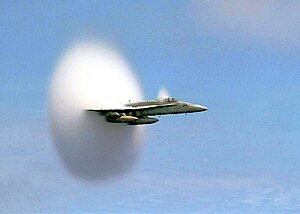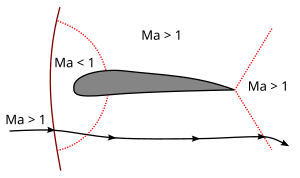Definition
Mach number (M or Ma) is a dimensionless quantity representing the ratio of speed of an object moving through a fluid and the local speed of sound.
General
The Mach number is commonly used both with objects traveling at high speed in a fluid, and with high-speed fluid flows inside channels such as nozzles, diffusers or wind tunnels. As it is defined as a ratio of two speeds, it is a dimensionless number. At Standard Sea Level conditions (corresponding to a temperature of 15 degrees Celsius), the speed of sound is 340.3 m/s (1225 km/h, or 761.2 mph, or 661.5 knots, or 1116 ft/s) in the Earth's atmosphere. The speed represented by Mach 1 is not a constant; for example, it is mostly dependent on temperature and atmospheric composition and largely independent of pressure. Since the speed of sound increases as the temperature increases, the actual speed of an object traveling at Mach 1 will depend on the fluid temperature around it. Mach number is useful because the fluid behaves in a similar way at the same Mach number. So, an aircraft traveling at Mach 1 at 20°C or 68°F, at sea level, will experience shock waves in much the same manner as when it is traveling at Mach 1 at 11,000 m (36,000 ft) at −50°C or −58F, even though it is traveling at only 86% of its speed at higher temperature like 20°C or 68°F.
Different Mach Regimes.
For comparison: the required speed for low Earth orbit is approximately 7.5 km/s = Mach 25.4 in air at high altitudes. The speed of light in a vacuum corresponds to a Mach number of approximately 881,000 (relative to air at sea level).
At transonic speeds, the flow field around the object includes both sub- and supersonic parts. The transonic period begins when first zones of M > 1 flow appear around the object. In case of an airfoil (such as an aircraft's wing), this typically happens above the wing. Supersonic flow can decelerate back to subsonic only in a normal shock; this typically happens before the trailing edge.
As the speed increases, the zone of M > 1 flow increases towards both leading and trailing edges. As M = 1 is reached and passed, the normal shock reaches the trailing edge and becomes a weak oblique shock: the flow decelerates over the shock, but remains supersonic. A normal shock is created ahead of the object, and the only subsonic zone in the flow field is a small area around the object's leading edge.
When an aircraft exceeds Mach 1 (i.e. the sound barrier) a large pressure difference is created just in front of the aircraft. This abrupt pressure difference, called a shock wave, spreads backward and outward from the aircraft in a cone shape (a so-called Mach cone). It is this shock wave that causes the sonic boom heard as a fast moving aircraft travels overhead. A person inside the aircraft will not hear this. The higher the speed, the more narrow the cone; at just over M = 1 it is hardly a cone at all, but closer to a slightly concave plane.
At fully supersonic speed, the shock wave starts to take its cone shape and flow is either completely supersonic, or (in case of a blunt object), only a very small subsonic flow area remains between the object's nose and the shock wave it creates ahead of itself. (In the case of a sharp object, there is no air between the nose and the shock wave: the shock wave starts from the nose.)
As the Mach number increases, so does the strength of the shock wave and the Mach cone becomes increasingly narrow. As the fluid flow crosses the shock wave, its speed is reduced and temperature, pressure, and density increase. The stronger the shock, the greater the changes. At high enough Mach numbers the temperature increases so much over the shock that ionization and dissociation of gas molecules behind the shock wave begin. Such flows are called hypersonic.
 |
| An F/A-18 Hornet creating a vapor cone at transonic speed just before reaching the speed of sound |
- M is the Mach number,
- v is the velocity of the source relative to the medium, and
- vsound is the speed of sound in the medium.
General
The Mach number is commonly used both with objects traveling at high speed in a fluid, and with high-speed fluid flows inside channels such as nozzles, diffusers or wind tunnels. As it is defined as a ratio of two speeds, it is a dimensionless number. At Standard Sea Level conditions (corresponding to a temperature of 15 degrees Celsius), the speed of sound is 340.3 m/s (1225 km/h, or 761.2 mph, or 661.5 knots, or 1116 ft/s) in the Earth's atmosphere. The speed represented by Mach 1 is not a constant; for example, it is mostly dependent on temperature and atmospheric composition and largely independent of pressure. Since the speed of sound increases as the temperature increases, the actual speed of an object traveling at Mach 1 will depend on the fluid temperature around it. Mach number is useful because the fluid behaves in a similar way at the same Mach number. So, an aircraft traveling at Mach 1 at 20°C or 68°F, at sea level, will experience shock waves in much the same manner as when it is traveling at Mach 1 at 11,000 m (36,000 ft) at −50°C or −58F, even though it is traveling at only 86% of its speed at higher temperature like 20°C or 68°F.
Different Mach Regimes.
| Regime | Mach | mph | km/h | m/s | General plane characteristics |
|---|---|---|---|---|---|
| Subsonic | <0.8 | <610 | <980 | <270 | Most often propeller-driven and commercial turbofan aircraft with high aspect-ratio (slender) wings, and rounded features like the nose and leading edges. |
| Transonic | 0.8-1.2 | 610-915 | 980-1,470 | 270-410 | Transonic aircraft nearly always have swept wings, delaying drag-divergence, and often feature design adhering to the principles of the Whitcomb Area rule. |
| Supersonic | 1.2–5.0 | 915-3,840 | 1,470–6,150 | 410–1,710 | Aircraft designed to fly at supersonic speeds show large differences in their aerodynamic design because of the radical differences in the behaviour of flows above Mach 1. Sharp edges, thin aerofoil-sections, and all-moving tailplane/canards are common. Modern combat aircraft must compromise in order to maintain low-speed handling; "true" supersonic designs include the F-104 Starfighter and BAC/Aérospatiale Concorde. |
| Hypersonic | 5.0–10.0 | 3,840–7,680 | 6,150–12,300 | 1,710–3,415 | Cooled nickel-titanium skin; highly integrated (due to domination of interference effects: non-linear behaviour means that superposition of results for separate components is invalid), small wings, such as those on the X-51A Waverider |
| High-hypersonic | 10.0–25.0 | 7,680–16,250 | 12,300–30,740 | 3,415–8,465 | Thermal control becomes a dominant design consideration. Structure must either be designed to operate hot, or be protected by special silicate tiles or similar. Chemically reacting flow can also cause corrosion of the vehicle's skin, with free-atomic oxygen featuring in very high-speed flows. Hypersonic designs are often forced into blunt configurations because of the aerodynamic heating rising with a reduced radius of curvature. |
| Re-entry speeds | >25.0 | >16,250 | >30,740 | >8,465 | Ablative heat shield; small or no wings; blunt shape |
High-speed flow around objects
Flight can be roughly classified in six categories:| Regime | Subsonic | Transonic | Sonic | Supersonic | Hypersonic | High-hypersonic |
|---|---|---|---|---|---|---|
| Mach | <0.8 | 0.8–1.2 | 1.0 | 1.2–5.0 | 5.0–10.0 | >10.0 |
At transonic speeds, the flow field around the object includes both sub- and supersonic parts. The transonic period begins when first zones of M > 1 flow appear around the object. In case of an airfoil (such as an aircraft's wing), this typically happens above the wing. Supersonic flow can decelerate back to subsonic only in a normal shock; this typically happens before the trailing edge.
As the speed increases, the zone of M > 1 flow increases towards both leading and trailing edges. As M = 1 is reached and passed, the normal shock reaches the trailing edge and becomes a weak oblique shock: the flow decelerates over the shock, but remains supersonic. A normal shock is created ahead of the object, and the only subsonic zone in the flow field is a small area around the object's leading edge.
 |  |
When an aircraft exceeds Mach 1 (i.e. the sound barrier) a large pressure difference is created just in front of the aircraft. This abrupt pressure difference, called a shock wave, spreads backward and outward from the aircraft in a cone shape (a so-called Mach cone). It is this shock wave that causes the sonic boom heard as a fast moving aircraft travels overhead. A person inside the aircraft will not hear this. The higher the speed, the more narrow the cone; at just over M = 1 it is hardly a cone at all, but closer to a slightly concave plane.
At fully supersonic speed, the shock wave starts to take its cone shape and flow is either completely supersonic, or (in case of a blunt object), only a very small subsonic flow area remains between the object's nose and the shock wave it creates ahead of itself. (In the case of a sharp object, there is no air between the nose and the shock wave: the shock wave starts from the nose.)
As the Mach number increases, so does the strength of the shock wave and the Mach cone becomes increasingly narrow. As the fluid flow crosses the shock wave, its speed is reduced and temperature, pressure, and density increase. The stronger the shock, the greater the changes. At high enough Mach numbers the temperature increases so much over the shock that ionization and dissociation of gas molecules behind the shock wave begin. Such flows are called hypersonic.
Calculation.
The Mach number at which an aircraft is flying can be calculated by- M is the Mach number
- v is velocity of the moving aircraft and
- vsound is the speed of sound at the given altitude
- qc is impact pressure (dynamic pressure) and
- p is static pressure
 is the ratio of specific heat of a gas at a constant pressure to heat at a constant volume (1.4 for air).
is the ratio of specific heat of a gas at a constant pressure to heat at a constant volume (1.4 for air).



![\mathrm{M}=\sqrt{\frac{2}{\gamma-1}\left[\left(\frac{q_c}{p}+1\right)^\frac{\gamma-1}{\gamma}-1\right]}\,](http://upload.wikimedia.org/math/6/e/6/6e6db7fda29c9dd1d793e86beb7c0cf6.png)
![\frac{q_c}{p} = \left[\frac{\gamma+1}{2}\mathrm{M}^2\right]^\left(\frac{\gamma}{\gamma-1}\right)\cdot \left[ \frac{\gamma+1}{\left(1-\gamma+2 \gamma\, \mathrm{M}^2\right)} \right]^\left(\frac{1}{ \gamma-1 }\right)](http://upload.wikimedia.org/math/f/6/d/f6d46166615bcc9e15ef31946fb29149.png)